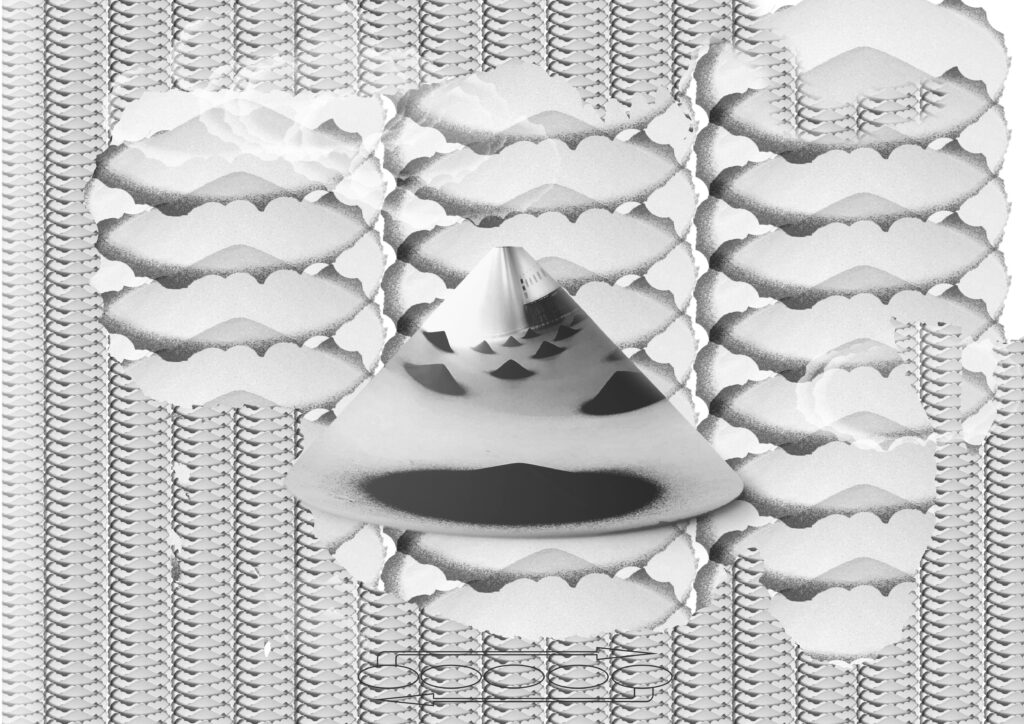
“Feedback Loop” by Mai Bauvald
Dear Friend,
I suppose I have fallen into some brilliant trap which I continue exploring. I first thought that it was my fascination with the social polarisation, our inability to meet, and furthermore some desire to solve the impossibilities. Yet, the truth is that I am not looking to meet anyone thinking otherwise, at least today. I have also been intrigued by being misunderstood, my voice getting disturbed or not heard at all. And it is possible that, at times, my hearing might have not been clear enough. You know when you say something and the other reads it in a surprising way? We all experience it. The message does not arrive or click inside the other. Giant steps away from all this fuss is the idea of transformation within, which happens rather rarely because of the circumstances that need to be in place. These are some mixed thoughts that I have been thinking about for a year, maybe more, proof of how painfully slow of a thinker I am. I found a piece that intrigues me in a similar manner – it is complex to comprehend and communicate – it is not impossible, just takes time and a commitment to the idea of reaching change in understanding. It is “Acting Things VII – School of Fluid Measures” by designer Judith Seng.
I first came across this piece in 2018 at the 4th Istanbul Design Biennial, titled “A School of Schools: Design As Learning”, and curated by Jan Boelen with Nadine Botha and Vera Sacchetti. “Acting Things VII – School of Fluid Measures”, an installation of 18 colourful pyramid-like sand piles in a simultaneously lively and sterile-looking white space, was one of the many “schools” of the biennale. The colourful sand piles have since been presented and explored in different cultural institutions, like Atelier Luma in Arles, France, and Z33, Hasselt, Belgium, and this year hopefully at the Tallinn Art Hall Gallery. This piece is not the first work in the series of “Acting Things”, in which Seng explores production processes. She is interested in daily situations and “tries to make these understandable as a work of design – a work that has been shaped, has a form and way of being performed…” Imagine an interaction at home, something as simple as washing the dishes. How is this communicated between the partners and then performed?
“Acting Things VII: School of Fluid Measures” aids us in discussing values through direct interaction with sand. The sand piles carry predetermined meanings or values, such as individuality, collectivity, freedom, responsibility, and standardization (among others) that can be mixed. It is interesting to read the reflections that people have had after a session of physical communication, where roles change in the process of negotiating perspectives. Not much is constant here, and (if you do not pre-coordinate) the results in the sand are unexpected. While working with Judith via Zoom calls on the exhibition for Tallinn, we discuss the different aspects of the work, and over time these calls have turned out to be like shifting sand as each time I get more nuance about the work and her practice.
Picture this. Blue sand on the floor in a perfect triangular pile. You are allowed to touch the pile, push it aside. You feel the grains slipping through your fingers. There is another pile in front of you that is, let’s say, yellow, and there is someone that moves these yellow grains toward what was previously your perfect blue pile. The two of you move together in silence, pushing, pulling, stroking, pouring, throwing, sweeping… Ideas reveal and conceal themselves in front of you slowly, clearly, and unclearly, through the process of looking, moving, interacting, and imagining.
We learn to communicate again. It always seems to take time when we touch the boundaries with our kitten paws. We try not to irritate. Then again, sometimes we use claws and make some marks that heal, though some traces remain. This piece in sand gives us the opportunity to refocus and perhaps even disturb our regular ways of communicating and negotiating our daily ways of being. Furthermore, here we focus on the act itself: communicating.
I had another moment of reflection after reading an interview with Wolfgang Tillmans in “Para-Platforms: On the Spatial Politics of Right-Wing Populism”, where in the end the artist concludes “complexity and the reality of being different will win.” My mind turned a somersault after realising that such an idea is possible, and “Acting Things” reappeared in my mind again. I guess this phrase captures my hope for the forthcoming installation – discussing social constructs and daily situations with an open mind and gentle heart.
But why did I mention transformation in the first place? I and, perhaps you agree, we often tend to have an impulse to try to understand something totally, permanently, in absolute terms. To keep an idea, we restrict ourselves, which can keep us afloat. The trap is this internal fight between dynamic and static. And when change (in values) happens, it can hurt or enrich. I see shifts and sometimes even earthquakes when I am teaching at the Art Academy, possibly one of the best environments for explosions, internal disturbances. Ideas can disrupt the ways students have seen themselves and their lives so far. It happened to me too, and I hope it continues happening. It could be as simple as a text, an artwork, a design discussed in a seminar that turns everything upside down. Sometimes new understanding creeps up on us calmly, when we have the willingness, environment, timing – the right context. But often, in reality understanding may take time.
Have I written a promotional confession? Maybe. Mostly I wish to meet you and learn more about ourselves.
Yours truly,
Sandra Nuut
Image “Feedback Loop” by Mai Bauvald.
Dear Friend in February 2021.